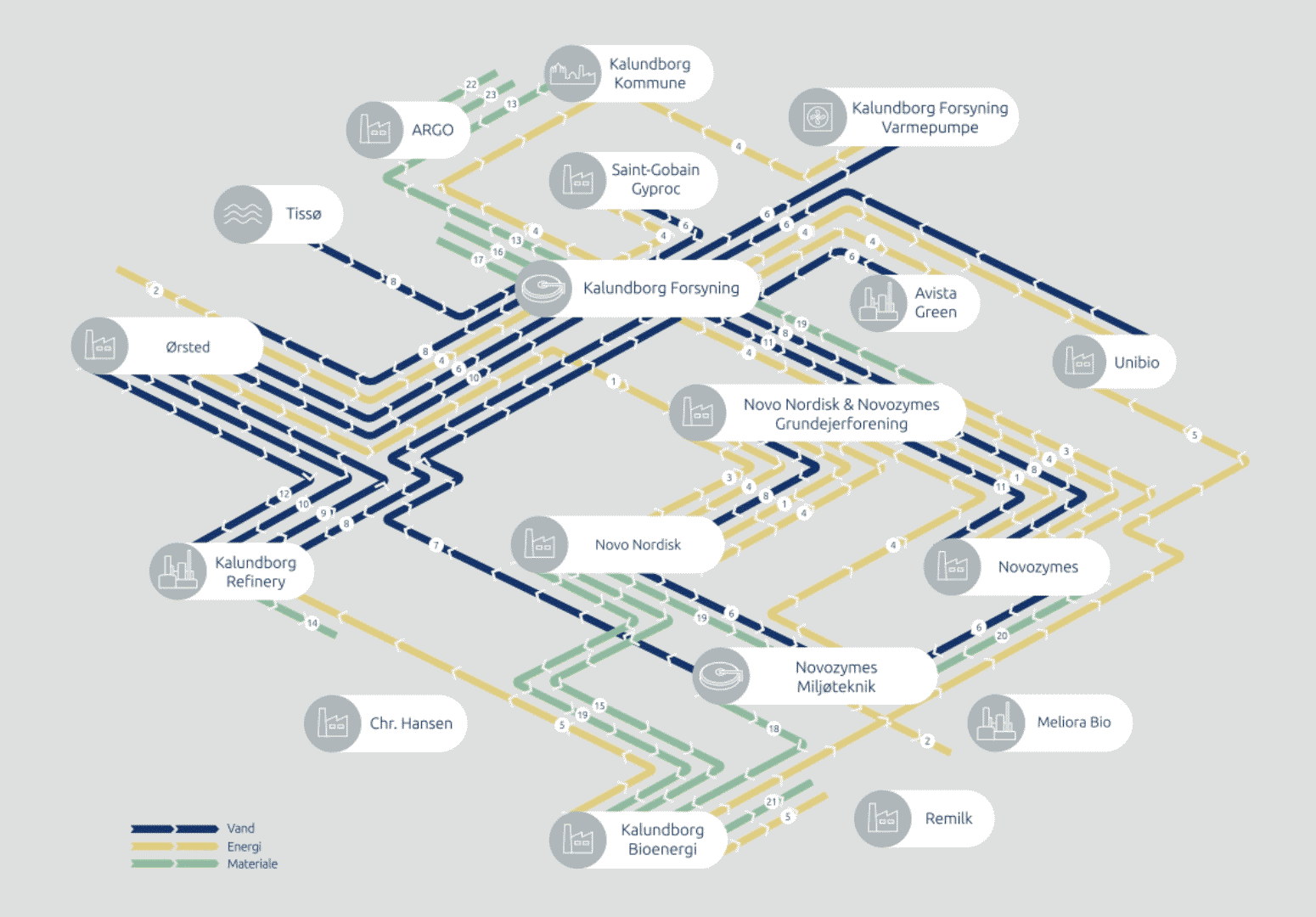Half a century of Industrial Symbiosis – Denmark offers a platform for success in biosolutions
Kalundborg’s Industrial Symbiosis model is a pioneering circular economy ecosystem where byproducts of one company become input for another, in a truly collaborative effort to optimize resources and increase efficiency across production facilities.
Starting with pragmatic origins in 1972, leaders from the local refinery and the gypsum board plant met to discuss how to swap resources to save costs in their local production sites, creating the first symbiosis project. From there, the local power plant and the refinery started to share water resources, while the production facility for Novo Nordisk delivered surplus of biological materials to farms in the area.
Industrial Symbiosis was born.
New opportunities for resource sharing were spotted. The power plant’s salt cooling water was used to produce trout and turbot at a local fish farm, while the refinery supplies biologically treated effluent water to the power plant, who in turn supplies calcium sulphate to the gypsum plant, replacing imported natural gypsum and avoiding a larger carbon footprint.
Over the past half century, new projects have expanded the symbiosis areas of circular production to the point where public and private companies are physically connected with more than 20 different streams of resource sharing. The partnerships include large and small companies, in addition to public institutions, across a range of industries and sectors.

Collaboration that makes a huge sustainable impact
A direct outcome is improved resource utilization that drives cost competitiveness, resilience in the supply chain, and sustainability. A lifecycle analysis completed for Kalundborg Symbiosis in 2020 found that the collaboration generates an annual savings of more than 3 million cubic tons of ground water and 62,000 tons of residual material that is recycled. It has generated an estimated 80 percent reduction in CO2 emissions since 2015, and the local energy is now carbon neutral.
An additional outcome of this collaboration is the expertise of the local partners and ecosystem developers that help to facilitate collaboration. Expertise – while hard to replicate – is something that Kalundborg is eager to share with other regions. Generations of cohorts with expertise and experience in “Industrial Symbiosis Facilitation” have been developed in Kalundborg, trained with engineering knowledge on material flows but equipped with a mind-set of identifying potential resource partnerships. The presence and expertise of these facilitators plays a crucial role in ensuring that collaboration opportunities are fully exploited.
“It is quite important to have a neutral partner in a symbiosis, to facilitate the network. Without having facilitators, it is difficult to see how the partners should be aware and allocate the right time to match-make and find each other to do projects together.”
Business Built on Trust
An even more precious commodity in the equation is trust, built up over a half a century of collaboration and seeking out opportunities for mutual benefit. Trust is something that has made the Kalundborg symbiosis a magnate for international investment. For example, in early 2022 the Israeli company ReMilk chose Kalundborg as a base for building the world’s largest precision fermentation facility to support its plan to produce animal-free dairy products. From its planned facility in Kalundborg, ReMilk plans to produce dairy-identical milk proteins through precision fermentation and has developed a unique and patented approach to scalable manufacturing, which dramatically increases efficiency in production - eliminating the need for dairy cows in industrial-scale dairy production - without compromising on taste, functionality, or nutritional values.“What made an impression on us as a newcomer was the people we met. It gave us a very good feeling of openness and transparency. We felt part of something that was bigger than what was happening in the room.”
“Trust and openness are core elements in a successful symbiosis partnership. Coming from different sectors, setups, and industries, we look at each other’s challenges and opportunities in new ways and transform this into new innovative projects.”
Platform for biosolutions
Building on its heritage but with a firm eye to the future, additional capacity and partnerships are being developed to ensure that the model established in Kalundborg will continue to thrive going forward.
Kalundborg Symbiosis and several of the partners located in Kalundborg are core members of the consortium for Biosolutions Zealand, a major project to drive the future of the local industrial biotech ecosystem based on the types of industrial partnerships nurtured in Kalundborg.
The consortium will fund investments in laboratory equipment, tests, demonstrations, production facilities, facilitate innovative collaborations between companies and universities and seek to strengthen education while attracting qualified skills to the region.
The project is part of a new political reform package for the Danish economy, allocating DKK 500 mio. to secure the future of Danish positions of strength. Better biosolutions will lead to green growth, export, and green jobs – and significantly contribution to the green transition in Denmark.
